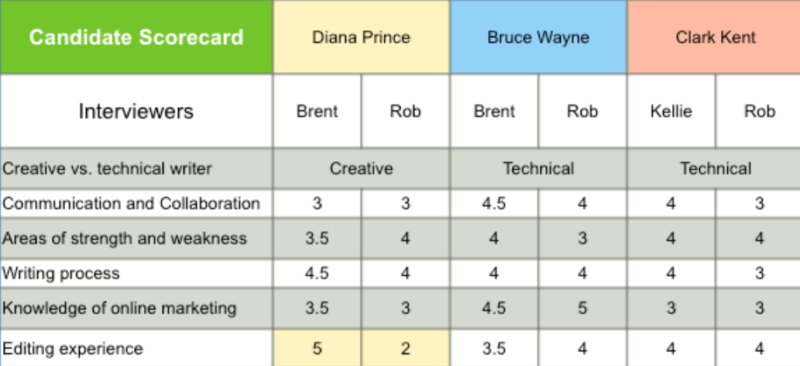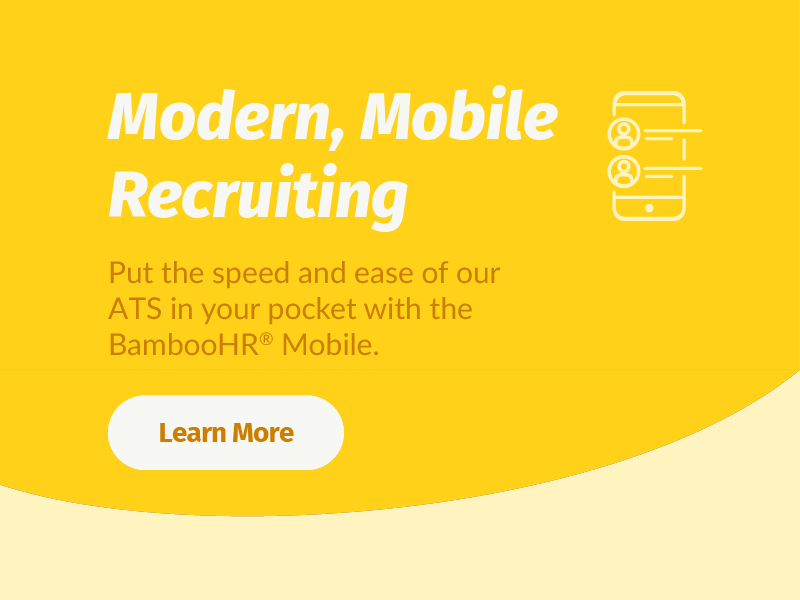How to Architect the Perfect Job Interview
Like many other business practices, the traditional job interview has practically reached the level of an oral tradition, a rite passed down from hiring manager to hiring manager. But in today’s high-stakes hiring environment where recruiting has to balance rapid hiring with long-term hiring quality, your recruiting process can’t rely on stale and unstructured interview strategies. Approaching interviews as an architect—consciously designing the process from its foundations to a purposeful outcome—helps you construct an exchange that gets the true measure of potential candidates while helping them connect with the experience they’ll have at your organization.
How to Think Like an Architect
In both the traditional and new, business-oriented sense of the word, effective architecture isn’t just about covering the basics and hoping for the best. You have to proactively consider the needs of the building and devise an expressive solution that reflects the building’s purpose.
Columned courthouses, for example, evoke an emotional response from everyone who enters, with rigid lines preparing them for the judgement that awaits within. By contrast, this cat-shaped kindergarten in Germany captures the imagination of its students.

The lack of architecture can send an equally powerful message—a cinder block shed may do its job, but only in the barest, most basic sense. It’s also entirely unremarkable and disposable.
Why Should You Avoid a Cinder-Block Approach to Interviews and Employment?
The Traditional Approach Isn’t Enough Anymore
For years, the employee-employer relationship has had the same utilitarian approach as cinder block sheds: the employer gives workers a paycheck for the work they performed, and that’s about where the relationship ends.
Traditional job interview questions match this philosophy, serving mostly to double-check the skills and experience listed in resumés during a perfunctory face-to-face meeting. If an employee has the on-paper requirements to complete the job and passes the gut check, they get the green light.
Today, though, employees expect more from their workplaces than just a paycheck and benefits. In a survey from PWC, 83 percent of employees selected “meaning in day-to-day work” as one of their top three priorities in their current job. Employees want their employment to reflect their personal values and contribute to their quality of life, both on and off the clock. They’re looking to build a personal legacy. They’re looking to architect.
An Unstructured Approach Gives You Ineffective Results
This level of alignment takes time, thought, and effort—resources hiring managers busy with their day-to-day responsibilities don’t often have in abundance. As a result, many people involved in the hiring process only do what they feel they have time for: they search for the top ten must-ask interview questions, read a few of the top articles in the search rankings, then come to the interview with a list of common questions, which will yield passable, myopic insight into the candidate’s abilities.
“Interviewers don’t know what they want to get out of the question half the time,” says JD Conway, head of talent acquisition at BambooHR. “Relying on a simple test of question and answer takes away their screening capacity for the candidate’s ability to do the job, perform well in it, their desire to grow in that job, and the overall match between the employer value proposition and the potential employee.”
Candidates Interview to Fit the Questions, Not the Company or the Job
Unfortunately, job candidates are doing their own research on the best ways to answer the top ten must-ask interview questions. This preparation helps them keep up a façade that checks all the boxes, leading to interviews that assess little more than the candidate’s ability to remember keywords.
Like the elaborate façades Grigory Potemkin supposedly built to impress Catherine the Great as she toured 18th-century Russia, candidates learn to build Potemkin villages with their interview responses. They’ve learned that projecting confidence is as important as the content of their responses, if not more. “Candidates might even try to find out the ‘right’ answers from people who work at the company,” JD adds, citing Glassdoor and company blogs as sources candidates check for buzzwords and priorities.
Without hiring strategy and support, your hiring managers end up spending their limited personal resources on interviews that mask your talent issues instead of building solutions for them.
How to Develop an Efficient, Targeted Interview Architecture
Thankfully, effective interviewing isn’t limited to finding the one perfect interview question. With the right architecture, interviews can lead to insightful exchanges between the candidate and interviewer. Knowing how to structure an interview can help hiring managers connect with candidates, make accurate assessments, and convince them to join your organization, resolving your talent needs.
Target Job Requisitions to Candidate Personas
Candidate personas provide a solid foundation for structuring interviews, beginning well before opening the position. Candidate personas help answer two pertinent questions:
- Who is this job for?
- What are those people doing right now?
Knowing these answers is like surveying the site for your next build. Each of the following personas have different motivations, time commitments, and daily schedules:
- People looking to re-enter the workforce after raising a family
- College students looking for stable employment to help them get through school
- A limited number of seasoned professionals in leadership positions
The hiring process will look different for each persona. While a single interview may be enough for some entry-level positions, leadership positions may present the challenge of scheduling interviews around busy professional schedules while respecting everyone’s time (and the candidate’s time foremost). “When we’re hiring senior payroll, we have to understand that, with their current jobs, they aren’t going to have a lot of time at the beginning or end of the quarter,” JD illustrates.
Choose the Interview Team
Determining who needs to interview candidates and provide input is the other half of right-sizing the interview process. While you don’t want to leave interviewing to a single person (and their personal biases), adding too many people to the interview presents its own challenges.
“In Lazlo Bock’s Work Rules!, he found out that the contribution to the results flatlines after four interview contributors,” JD says. “So it’s as possible for companies to add too many steps as it is for them not to add enough.”
Each interviewer should have a clear understanding of the group they’re interviewing, the skills and attributes they’re measuring, and the unique insights they can offer based on their own position as the new hire’s future co-worker, manager, or leader.
Create Candidate Scorecards
While an interview shouldn’t be a rigid set of predetermined questions, the interviewing team can coordinate to set up a structure for attributes they want to compare when deciding whom to hire. Taking notes on their impressions in these key areas helps keep interviewers focused on the essentials behind the answers instead of trying to factor each answer into an overall candidate rating.

Candidate scorecards can also help spot and mitigate biased reactions to interviewing questions. In the example above, there’s a large variation in ratings for one of the candidates, indicating that Brent and Rob need to discuss the reasoning for their rating.
Use Follow-Up Questions to Interview with a Purpose
With this preparation beforehand, interviewers can come prepared to ask follow-up questions. This helps the interview go beyond what the candidate has done in previous positions and uncover why they took those actions.
So instead of asking the question “What is your greatest weakness?” and getting a prepared humble-brag while the panel of interviewers zones out, follow-up questions can uncover the bigger pattern of the candidate’s career. For example:
Interviewer: Can you tell me about collaborating with co-workers?
Candidate: Well, at my last job, I made it a priority to send notifications on time, even if no one read them on time.
Interviewer: So when people didn’t read their email, what else did you do to communicate and keep things on schedule?
With the focus on the previously-determined areas listed on the scorecard, everyone in the interview can follow along these lines of questioning and add insights instead of tangents.
Draw the Candidate into the Conversation
During an architected interview, engaged candidates may follow your follow-up questions with probing questions of their own. Coming prepared to respond with the reasons your organization values the attributes on your scorecard can help you show these candidates the thoughtfulness you put into this interview and leave them with a favorable impression of your organization.
Candidate: Do you often have problems with late responses for projects?
Interviewer: We’re a smaller organization, so our team does hit our bandwidth sometimes. Adding more people should help, but everyone needs to stay proactive to keep things going smoothly.
These exchanges can help the candidate discover what you’re looking for and reassure them your organization has a solid foundation and plans for the future. Added transparency during the interview can help them make the right decision for their career now—instead of rethinking the great job you offered after you’ve spent time and resources training them.
Building a Great Organization One Honest Interview at a Time
It can take more time and effort to carefully architect an interview instead of relying on traditional formalities. But these efforts pay off in long-term retention as an open exchange of expectations and possibilities helps new hires forge strong, authentic connections with your organization. Thoughtful interview questions can be the foundational layer for new employees to begin building their part of your shared legacy.
Get caught up every month on all things HR. Don't worry, we promise we won't spam you.
Brian Anderson expertly decodes all things HR, drawing on a decade of technical writing in the business organization industry to provide editorial support to internal and external learning programs at BambooHR. His writing explores the different motivations that shape the employee experience and the psychology of human resources.











